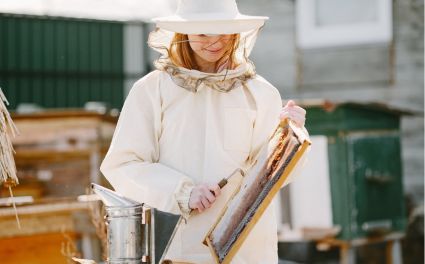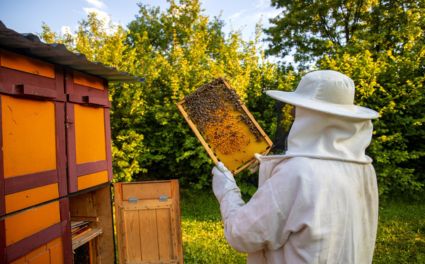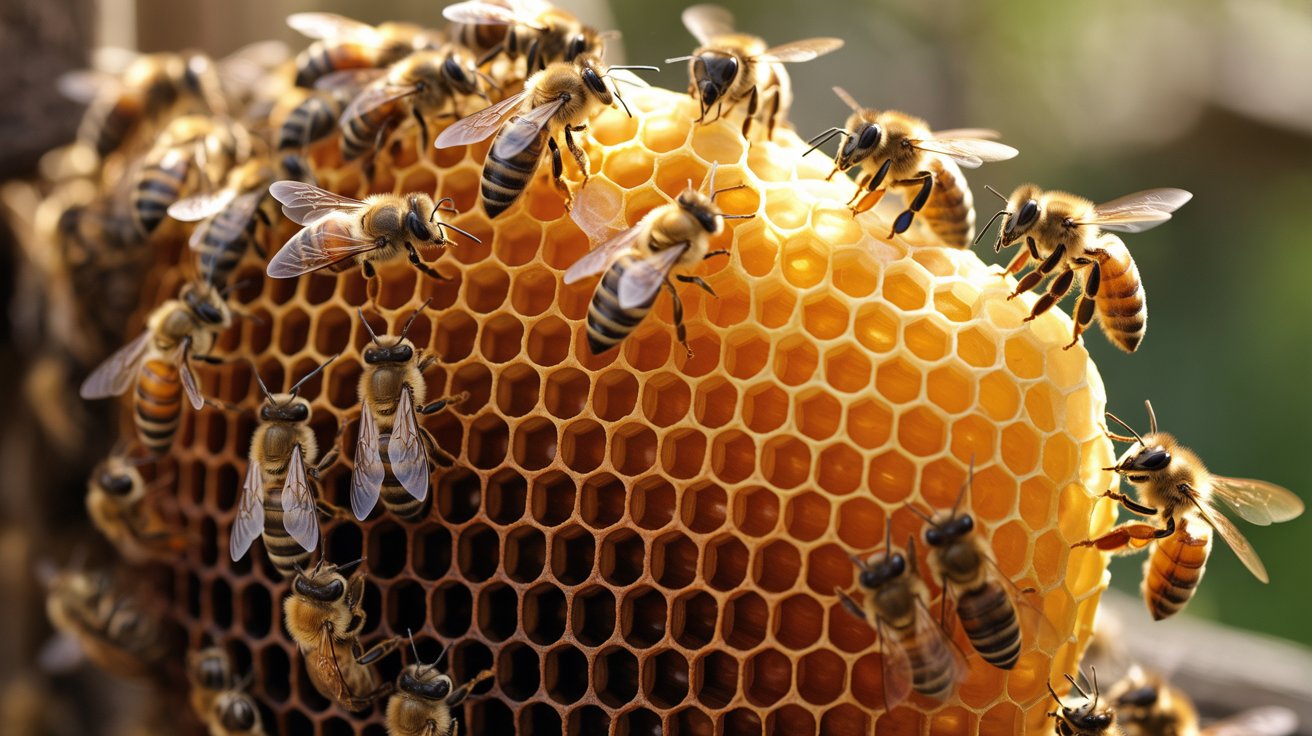Have you ever been amazed by how perfectly structured a beehive looks or how beautifully designed a honeycomb is? These natural creations, built by thousands of hardworking bees, are more than just visual wonders — they are masterpieces of organization, teamwork, and precision.
In this blog, we’ll explore the intricate world of beehives and honeycombs, uncovering how they function, what makes them so efficient, and why humans have taken inspiration from them for centuries.
Whether you’re a nature lover or a beekeeper wearing your beekeeping suits, this journey will help you appreciate how bees shape their environment with remarkable intelligence and cooperation.
Beehive: Nature’s Complex Social Hub
In the buzzing world of bees, the beehive represents the ultimate symbol of social order and design. It’s not just a shelter — it’s a perfectly coordinated living system where every bee plays its part.
Definition and Purpose of a Beehive
A beehive serves as the colony’s headquarters — the central structure where thousands of bees live, work, and protect their resources. It offers warmth, shelter, and a safe environment for breeding and storing honey. The hive is more than a home; it’s a living example of how order and cooperation sustain life.
Structure and Components of a Beehive
Outer Shell and Protection:
The hive’s exterior is designed like a fortress.Bees use beeswax, propolis, and resin to reinforce the outer walls, creating insulation against heat, cold, and predators.
Inner Compartments:
Inside, the hive is a well-organized system of hexagonal cells made of wax. Each section has a specific purpose — from nurseries for larvae to storage chambers for honey and pollen. The precision of this internal layout ensures that not a single space goes to waste.
Queen Bee’s Chamber and Worker Zones:
At the heart of the hive lies the queen’s chamber — a secure area where she lays thousands of eggs. Surrounding her are the worker bee zones and honey storage cells. Every area is meticulously arranged, showing how perfectly bees manage their resources.
Social Organization Within the Hive
The beehive thrives on teamwork and communication. Worker bees collect nectar, guard the entrance, and tend to the young. Drones help with reproduction, while the queen focuses on egg-laying.
Bees communicate through pheromones and their famous “waggle dance,” which directs others toward nectar-rich flowers. This coordination keeps the hive balanced and productive, mirroring a well-organized society.

Honeycomb: Nature’s Masterpiece of Design
At the core of every beehive lies the honeycomb, a true marvel of natural engineering. It’s not only beautiful to look at — it’s also an example of how nature achieves perfect efficiency using the least resources possible.
Role of the Honeycomb in a Beehive
Honey and Pollen Storage:
Honeycomb cells serve as natural storage units. Worker bees deposit nectar inside and seal it once it turns into honey. Similarly, pollen — a vital protein source — is stored here for future use.
Larvae Development:
The queen bee lays her eggs in special brood cells. These compartments provide a warm and protective space where larvae grow until they become adults.
The hexagonal pattern of the honeycomb ensures maximum storage space using minimal wax — a principle that continues to inspire modern architecture and design.
Building the Honeycomb
The construction of the honeycomb demonstrates the bees’ unmatched precision. Worker bees secrete wax from glands on their abdomen, chew it to soften it, and then shape it into hexagonal cells.
The hexagon is nature’s perfect shape — strong, space-saving, and material-efficient. This structure allows bees to store large amounts of honey and pollen while maintaining stability even under pressure.
Mathematical and Engineering Elegance
The honeycomb pattern has long fascinated mathematicians and engineers. As early as the 17th century, the German mathematician Johannes Kepler studied the efficiency of hexagonal designs. Hexagons, he found, can divide a space into equal parts using the smallest possible perimeter.
Today, engineers use this same logic when designing lightweight but strong materials — from airplane components to building walls. It’s a perfect example of how nature inspires human innovation.
Functionality and Environmental Importance
Beyond their beauty, beehives and honeycombs serve vital ecological functions.
Pollination and Biodiversity
As bees move from flower to flower collecting nectar, they unintentionally transfer pollen — a process crucial to plant reproduction. This pollination helps grow fruits, vegetables, and countless other crops. Without bees, global food production would suffer dramatically.
Supporting Agriculture
Bees contribute to the health of ecosystems and farming industries alike. Their pollination boosts crop yields and sustains biodiversity. Protecting bee populations ensures that this balance remains intact.
Honeycomb as Nature’s Storage Genius
Honey is not just a food source for bees — it’s also one of nature’s most efficient preservation methods. Sealed inside the hexagonal cells, honey remains protected from moisture and bacteria, allowing it to last for years.
For humans, honey is both a sweetener and a natural health supplement. Its vitamins, minerals, and enzymes make it one of the most versatile foods ever produced by nature.
Human Inspiration and Beekeeping Practices
From Ancient Traditions to Modern Beekeeping
Humans have admired and learned from bees for thousands of years. Ancient civilizations practiced beekeeping, observing how bees built hives and stored honey. This led to the development of protective gear and tools that made beekeeping safer and more efficient.
Modern apiarists use beekeeping jackets, beekeeping gloves, and beekeeping veils to work closely with bees while staying safe. Protective clothing is an essential part of beekeeping, allowing people to interact with colonies without causing harm or getting stung.
For full-body safety, many prefer beekeeping suits or separate beekeeping trousers paired with beekeeping ankle protection to ensure no bee can sneak in.
Even young learners can explore this world safely by wearing beekeeping kids suits designed for comfort and security.
Cultural and Symbolic Significance
Bees and their architecture have inspired human art, religion, and science. Ancient Egyptians associated bees with rebirth and abundance. Many cultures viewed the hive as a symbol of community — every individual working toward a shared purpose.
This symbolism remains powerful today, reminding us that cooperation and harmony can achieve remarkable things — just like bees do in their hives.
Environmental Challenges and Conservation
Despite their strength and adaptability, bees face serious threats. Habitat loss, pesticide exposure, and climate change contribute to declining bee populations worldwide. One major concern is Colony Collapse Disorder (CCD), where worker bees suddenly vanish, leaving behind the queen and larvae.
The loss of bee colonies affects pollination, crop yields, and biodiversity — making conservation efforts essential.
Sustainable and Urban Beekeeping
Supporting sustainable beekeeping can help protect these vital pollinators. Brands like OZ Armour promote awareness about responsible beekeeping by offering durable and safe gear that protects both the beekeeper and the bees.
Urban beekeeping, where hives are kept on rooftops or gardens, is growing in popularity as people recognize the importance of restoring bee populations even in cities.
For those new to the craft, reading educational resources and blogs can help build knowledge and confidence.
👉 Read more blogs about beekeeping to discover tips, tools, and insights for modern sustainable beekeeping.

Final Thoughts
The beehive and honeycomb are more than just structures — they are masterpieces of natural design, teamwork, and resilience. From the queen’s chamber to the hexagonal honey cells, every element serves a precise function, proving that nature wastes nothing.
As humans continue to learn from bees, we not only appreciate their engineering brilliance but also their lessons in unity and cooperation.
Whether you’re studying bee behavior or working in your apiary wearing a beekeeping suit, remember — each hive you care for contributes to a thriving ecosystem.
To explore professional-grade beekeeping gear, including jackets, suits, gloves, veils, trousers, kids suits, and ankle protection, visit OZ Armour — a trusted name known for quality, comfort, and innovation in beekeeping protection.



